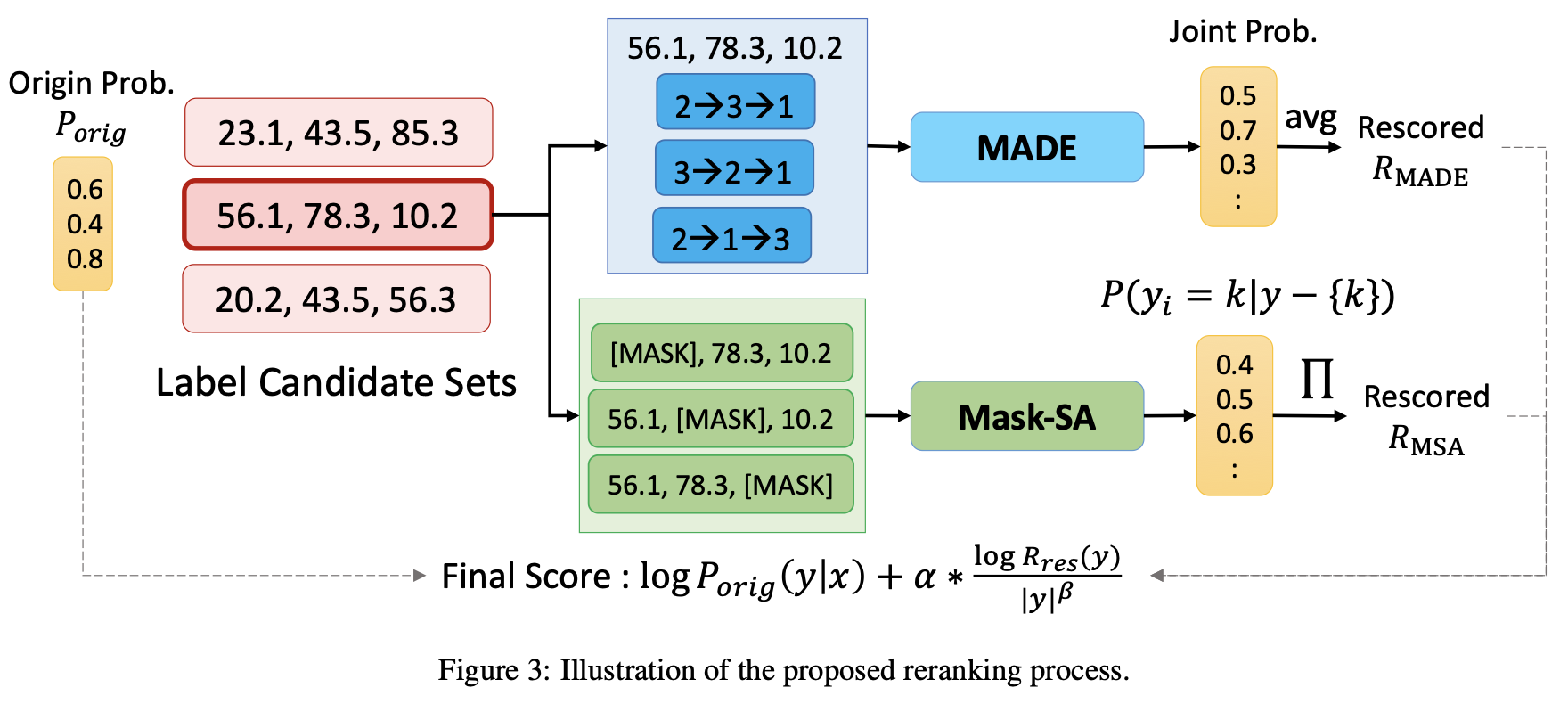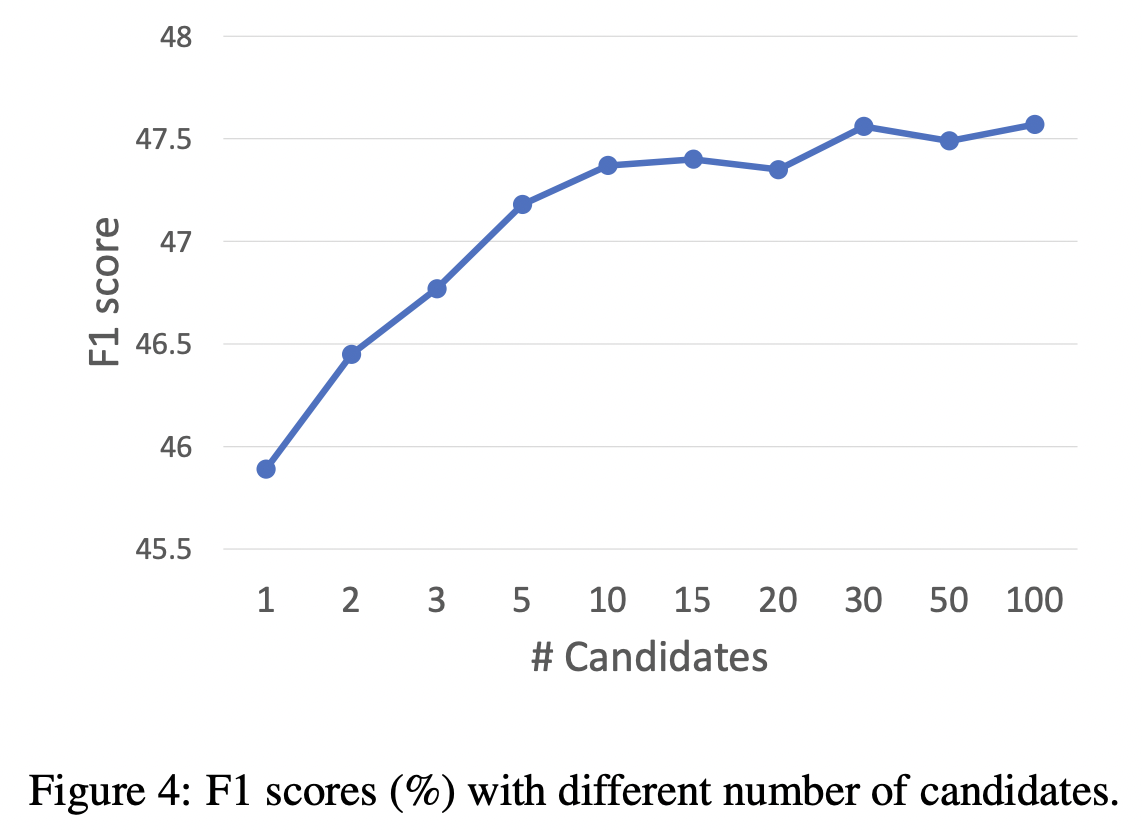Modeling Diagnostic Label Correlation for Automatic ICD Coding
NAACL 2021,提出了一个two-stage框架以捕获标签相关性,提升自动ICD编码的性能。

Overview

- paper: https://aclanthology.org/2021.naacl-main.318.pdf
- code: https://github.com/MiuLab/ICD-Correlation
Background
国际疾病分类(International Classification of Disease, ICD),是根据疾病的某些特征,采用编码方法来表示的系统。自动ICD编码近年来是一个热点任务,一般将其当作多标签分类问题处理。ICD编码呈现层次结构,因此考虑标签相关性很重要。
本文受自动语音识别和依存分析中reranking技术的启发,本文为ICD编码提出了一个two-stage的reranking框架,不需要任何专家知识也可以捕获标签相关性。
Method
本文提出的框架分为两个阶段:
- 标签候选集生成,采用基本的分类器得到标签概率。
- 标签候选集重排,利用标签相关性重排候选标签。
Candidate Generation
此阶段产生top-k的标签集合,给定标签概率\(P_{base}(y_i=1|\mathbf{x}, \theta_{base}),\ i=1,2,\cdots,|\mathcal{Y}|\),标签集合的概率为各标签的概率乘积: \[ P_{base}(\hat{\mathbf{y}}|\mathbf{x}, \theta_{base}) = \prod_{i=1}^{|\mathcal{Y}|}P_{base}(y_i=\hat{\mathbf{y}_i}|\mathbf{x}, \theta_{base}) \]
虽然标签组合共有\(2^{|\mathcal{Y}|}\)个子集,但可以采用动态规划的方式高效生成。
[ICML 2016] Conditional bernoulli mixtures for multi-label classification [paper]
def get_n_best(probs, n=10):
flip_idx = np.argsort(np.abs(probs-0.5))[:n]
labels = np.zeros(len(probs))
cum_prob = 0.0
for i, prob in enumerate(probs):
if i in flip_idx:
continue
if prob >= 0.5:
labels[i] = 1
cum_prob += np.log(prob)
else:
labels[i] = 0
cum_prob += np.log(1-prob)
last_queue = PriorityQueue()
last_queue.put((cum_prob, labels))
for i, prob in enumerate(probs):
if i not in flip_idx:
continue
queue = PriorityQueue()
for cum_prob, labels in last_queue.queue:
labels2 = np.copy(labels)
labels[i] = 1
queue.put((cum_prob + np.log(prob+1e-6), labels))
labels2[i] = 0
queue.put((cum_prob + np.log(1-prob+1e-6), labels2))
while len(queue.queue) > n:
_ = queue.get()
last_queue = queue
n_best = []
while not queue.empty():
n_best.append(queue.get())
n_best = n_best[::-1]
return n_bestCandidate Reranking
基本分类器假设标签是独立的,为此本文引入了标签集合的重排器(reranker),以捕获标签的共享性与共现性。
给定候选集\(\hat{\mathbf{y}}\),重排器计算得分\(R(\hat{\mathbf{y}})\),根据得分的加权和重排。 \[ \log P_{base}(\hat{\mathbf{y}}|\mathbf{x},\theta_{base})+\alpha\cdot R(\hat{\mathbf{y}}) \] 其中\(\alpha\)为超参数。本文设计了两个reranker用于重排,分别是MADE和Mask-SA,如下图所示。

MADE采用了一个掩码自编码器估计密度,通过自回归的方式估计联合概率\(P(\hat{\mathrm{y}})\)。 \[ P_{MADE}(\hat{\mathrm{y}})=\prod_{i=1}^{|\mathcal{Y}|}P_{MADE}(y_i=\hat{\mathrm{y}}_i|\hat{\mathrm{y}}_{o<i},\theta_{MADE}) \] 其中\(o\)表示\(\{1,2,\cdots,|\mathcal{Y}|\}\)中的随机排列,\(o(i)\)表示新的排序,\(\hat{\mathrm{y}}_{o<i} = \{\hat{\mathrm{y}}_j|o(j)<o(i)\}\)表示新的排序中先于\(\hat{\mathrm{y}}_i\)的所有元素集合。
给定候选集\(\hat{\mathrm{y}}\),MADE得分定义为 \[ R_{MADE}(\hat{\mathrm{y}}) = \frac{\log P_{MADE}(\hat{\mathrm{y}})}{|\hat{\mathrm{y}}|^{\beta}} \] 其中\(|\hat{\mathrm{y}}|\)表示子集的大小,作为一个长度惩罚项,作者发现不加这一项的话模型容易偏向更小的集合。
此外,受BERT的MLM启发,作者还提出了一个掩码自注意力重排器Mask-SA。将对角线的标签掩码,输入到BERT中做MLM。
input_ids, attention_mask = build_masked_input(
token_ids, tokenizer, mask_positions=[i]
)
all_input_ids.append(input_ids)
all_attention_mask.append(attention_mask)
all_input_ids = torch.tensor(all_input_ids).cuda()
all_attention_mask = torch.tensor(all_attention_mask).cuda()
with torch.no_grad():
output = model(all_input_ids, all_attention_mask)
prediction_scores = output[0]
log_prob = 0.0
for i, token_id in enumerate(token_ids):
log_prob += prediction_scores[i, i].detach().log_softmax(dim=-1)[token_id].cpu().item()
nbests_with_bert.append((0.0, log_prob, len(token_ids), prob, labels))这实际上等价于预测其他标签的概率\(P_{MSA}(\hat{\mathrm{y}}_i|\hat{\mathrm{y}}-\{\hat{\mathrm{y}}_i\},\theta_{MSA})\),最终的得分定义为 \[ R_{RSA}(\hat{\mathrm{y}})=\frac{\log\prod_{i=1}^{|\hat{\mathrm{y}}|}P_{MSA}(\hat{\mathrm{y}}_i|\hat{\mathrm{y}}-\{\hat{\mathrm{y}}_i\},\theta_{MSA})}{|\hat{\mathrm{y}}|^{\beta}} \]
Experiment
选取MIMIC-2和MIMIC-3数据集,MIMIC-2有5031个标签,MIMIC-3有8922个标签。

